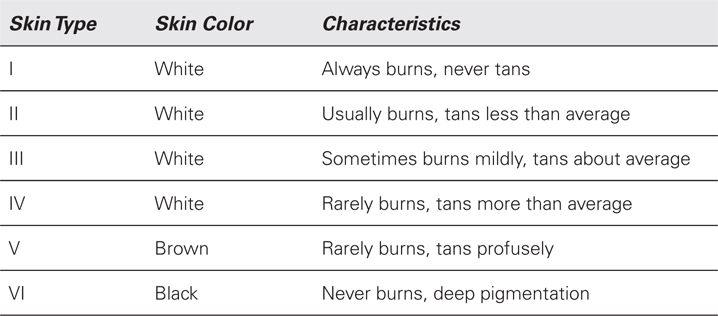What are the three most common skin-resurfacing modalities?
1. Lasers
2. Chemical peels
3. Dermabrasion
 Skin-resurfacing procedures are particularly good to treat what two conditions?
Skin-resurfacing procedures are particularly good to treat what two conditions?
1. Facial wrinkles
2. Blotchy facial skin pigmentation changes
 What is the Fitzpatrick skin type classification?
What is the Fitzpatrick skin type classification?

 What is the significance of Fitzpatrick skin type in preoperative evaluation for facial resurfacing?
What is the significance of Fitzpatrick skin type in preoperative evaluation for facial resurfacing?
Fitzpatrick skin type helps predict the risk of hyperpigmentation changes following a skin-resurfacing procedure.
 What Fitzpatrick type of skin has the lowest risk of hyperpigmentation following skin resurfacing?
What Fitzpatrick type of skin has the lowest risk of hyperpigmentation following skin resurfacing?
Fitzpatrick I, II, and III.
A subepidermal region of dermis where neocollagen formation by fibroblasts occurs after wounding or actinic damage.
 What is the relevance of the “grenz zone”?
What is the relevance of the “grenz zone”?
The thickness of fibroplasia within the grenz zone is directly proportional to the strength of the wounding agent. In addition, this area is thought to be responsible for the regenerative changes in the skin seen after resurfacing treatments.
 How long should one wait to perform full facial resurfacing after a face-lift?
How long should one wait to perform full facial resurfacing after a face-lift?
Classically, at least 3 months to allow the skin to heal fully prior to additional vascular insult.
 Why should one stop Accutane (isotretinoin) prior to any kind of resurfacing procedure?
Why should one stop Accutane (isotretinoin) prior to any kind of resurfacing procedure?
Accutane causes atrophy of pilosebaceous glands and therefore impaired reepithelialization and wound healing.
 How long should one stop Accutane (isotretinoin) prior to any kind of resurfacing procedure?
How long should one stop Accutane (isotretinoin) prior to any kind of resurfacing procedure?
At least 1 year should pass after stopping Accutane to give the adnexal structures (epithelial cells, hair follicles) a chance to regrow and reactivate so proper healing (reepithelialization) can occur after resurfacing.
 When can the patient begin wearing makeup following skin resurfacing?
When can the patient begin wearing makeup following skin resurfacing?
After full healing, or reepithelialization, is well under way. Typically 7 to 10 days after treatment.
 Should patients scrub their faces after resurfacing to get rid of old, dead skin?
Should patients scrub their faces after resurfacing to get rid of old, dead skin?
Absolutely not. While gentle cleansing is essential; flaky, peeling skin should be left alone after a treatment and allowed to slough naturally. Any interference by picking or peeling could result in severe scar formation or poorly healed wounds.
 What are contraindications to skin-resurfacing procedures?
What are contraindications to skin-resurfacing procedures?
1. Active facial/oral herpes simplex infection or zoster
2. Skin disorders that affect healing (e.g., scleroderma, cutis laxa)
3. Planned future excessive sun exposure
4. History of extensive electrolysis or laser hair removal to the area
5. History of keloid/hypertrophic scarring
6. Recent facial procedures (relative contraindication)
7. Documented hypersensitivity to peeling agents
8. Accutane (isotretinoin) use within 1 year
9. Pregnancy
10. Immunodeficiency
11. Prior radiation therapy to the area
12. Recent chemotherapy
13. Unrealistic expectations
A process by which different chemical agents are applied to the skin to cause a caustic injury and chemical necrosis of the skin to variable depths to remove variable amounts of skin to effect healing and subsequently, a more youthful appearance.
 What factors may affect the depth of chemical peeling?
What factors may affect the depth of chemical peeling?
1. Presence of skin surface oils
2. Skin water content
3. Temperature of the room, skin, and solution
4. Humidity of the air
5. Length of time the solution is in contact with the skin or number of applications
6. Use of occlusive or nonocclusive dressings
7. Inherent thickness of epidermis and dermis
8. Batch of peel reagent
 Which is the most “predictable” peeling agent?
Which is the most “predictable” peeling agent?
Phenol.
 What products are typically used for a “pre-peel regiment”?
What products are typically used for a “pre-peel regiment”?
Hydroquinone (bleaching agent), Retin-A (tretinoin), alpha-hydroxy acid (AHA) cream (glycolic acid), sunscreen, moisturizers for at least 2 to 6 weeks. In addition, most patients (depending on their history) should be immediately pretreated with an oral antiviral agent for prophylaxis against herpes simplex virus infection. Many practitioners also administer antibiotics beforehand.
 What effect does Retin-A have on the epidermis?
What effect does Retin-A have on the epidermis?
Thins the stratum corneum, suppresses melanocytes, melanocyte granules are more evenly distributed, cellular portion thickens, increased vertical polarity of basal layer.
Stay updated, free articles. Join our Telegram channel

Full access? Get Clinical Tree


 What is the “grenz zone”?
What is the “grenz zone”? What is a chemical peel?
What is a chemical peel?